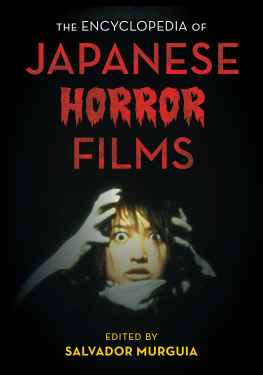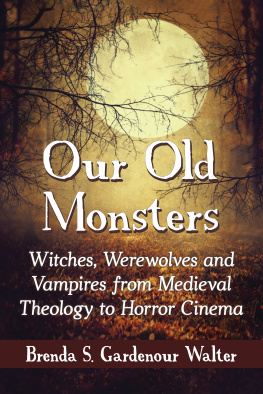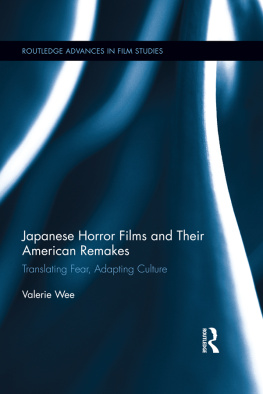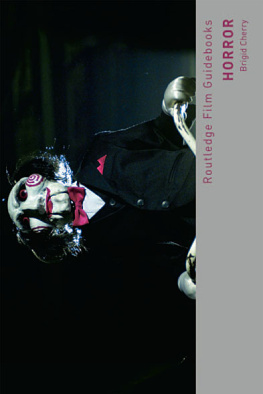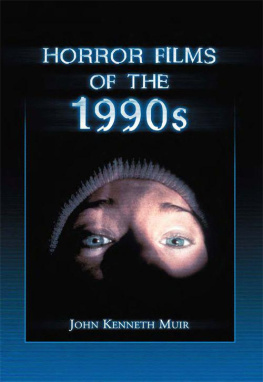Contents
Monsters, Demons
and
Psychopaths
Psychiatry and Horror Film
Monsters, Demons
and
Psychopaths
Psychiatry and Horror Film
Fernando Espi Forcen

CRC Press
Taylor & Francis Group
6000 Broken Sound Parkway NW, Suite 300
Boca Raton, FL 33487-2742
2017 by Taylor & Francis Group, LLC
CRC Press is an imprint of Taylor & Francis Group, an Informa business
No claim to original U.S. Government works
Printed on acid-free paper
Version Date: 20160607
International Standard Book Number-13: 978-1-4987-1785-4 (Paperback)
This book contains information obtained from authentic and highly regarded sources. While all reasonable efforts have been made to publish reliable data and information, neither the author[s] nor the publisher can accept any legal responsibility or liability for any errors or omissions that may be made. The publishers wish to make clear that any views or opinions expressed in this book by individual editors, authors or contributors are personal to them and do not necessarily reflect the views/opinions of the publishers. The information or guidance contained in this book is intended for use by medical, scientific or health-care professionals and is provided strictly as a supplement to the medical or other professionals own judgement, their knowledge of the patients medical history, relevant manufacturers instructions and the appropriate best practice guidelines. Because of the rapid advances in medical science, any information or advice on dosages, procedures or diagnoses should be independently verified. The reader is strongly urged to consult the relevant national drug formulary and the drug companies and device or material manufacturers printed instructions, and their websites, before administering or utilizing any of the drugs, devices or materials mentioned in this book. This book does not indicate whether a particular treatment is appropriate or suitable for a particular individual. Ultimately it is the sole responsibility of the medical professional to make his or her own professional judgements, so as to advise and treat patients appropriately. The authors and publishers have also attempted to trace the copyright holders of all material reproduced in this publication and apologize to copyright holders if permission to publish in this form has not been obtained. If any copyright material has not been acknowledged please write and let us know so we may rectify in any future reprint.
Except as permitted under U.S. Copyright Law, no part of this book may be reprinted, reproduced, transmitted, or utilized in any form by any electronic, mechanical, or other means, now known or hereafter invented, including photocopying, microfilming, and recording, or in any information storage or retrieval system, without written permission from the publishers.
For permission to photocopy or use material electronically from this work, please access www.copyright.com (http://www.copyright.com/) or contact the Copyright Clearance Center, Inc. (CCC), 222 Rosewood Drive, Danvers, MA 01923, 978-750-8400. CCC is a not-for-profit organization that provides licenses and registration for a variety of users. For organizations that have been granted a photocopy license by the CCC, a separate system of payment has been arranged.
Trademark Notice: Product or corporate names may be trademarks or registered trademarks, and are used only for identification and explanation without intent to infringe.
Visit the Taylor & Francis Web site at
http://www.taylorandfrancis.com
and the CRC Press Web site at
http://www.crcpress.com
This book is dedicated to my father who introduced us to his passion for the seventh art.
Contents
As long as I can remember, Ive always loved horror. When I was a kid, my brothers and I had a special way of playing hide and seek. My father used to hide in one of the rooms of the house with the lights off and each one of us had to walk through the corridor not knowing where he was going to unexpectedly scare us. I remember with nostalgia the mixed feelings of fear, joy and excitement I experienced right before walking down the corridor. During my childhood, my cousins, my friends and I enjoyed telling each other horror stories about serial killers, urban legends or dangerous madmen that had escaped from the asylum. The first horror film I ever saw was The Cabinet of Dr. Caligari, a 1920 German silent movie. I was six years old and my father had told us that our grandfather was terrorized when he had watched it as a youngster. After watching the film I slept under the covers for at least a couple of weeks, scared by the feeling that the sleepwalker, Cesare, would come any minute to decide my fate.
One of those summers, while spending the holidays at a small town by the beach in Spain, my father shared with us the story of Night of the Living Dead, the 1968 movie which he had watched as a teenager and which was the scariest movie he had ever seen. Many years later during residency, together with my father, I visited the cemetery of Evans City, Pennsylvania, where several scenes had been shot.
Our caretaker at home, Moni, was in fact a horror film fan and she used to summarize for us the stories of Alien, A Nightmare on Elm Street, Friday the 13th and other classics. At that time our parents did not allow us to see those films and I had to wait for my teenage years. However, one night, when my twin brother Carlos and I were still children, my parents went out for dinner and left us in the care of my grandmother. That night, Stanley Kubricks The Shining was playing on TV. My father had given instructions to my grandmother that she was not to allow us to see the film, something we were unaware of, but she fell asleep very quickly and we ended up watching that entire work of genius. I still remember my surprise when I watched the transformation from beauty to ugliness of the woman in Room 237.
I was eleven when I saw my first horror film in the theater: Bram Stokers Dracula by Francis Ford Coppola. We sneaked into the theater, and the excitement and fear I felt was comparable to that Id experienced as a kid right before walking down the dark corridor. I get a similar feeling every time I watch a new good scary movie now. I guess, at an early stage of development, I became somehow psychologically eroticized by horror and have been that way ever since. Today, at times when I am stressed, horror movies allow me to escape, relax and return to my happy upbringing.
I havent just been fascinated by horror; cinema in general has been the one passion I inherited from my father. Despite going to a Catholic school in Murcia, in southeastern Spain, religion was not my thing. Luckily, in my school, the Marist Brothers were liberal enough. During my last year of high school, we were allowed to start a movie club as a substitute for catechism for those who were not interested in the sacrament of Confirmation. We worked under the supervision of Brother Soriano, who had studied cinema. Our movie club was poorly attended, though; most students were interested in receiving Confirmation. However, Brother Soriano helped us look at cinema in an academic way and opened our minds to new perspectives. I used the skills I had learned from Brother Soriano during medical school and designed a module for my classmates about cinema and medical psychology.
After medical school I left Spain to pursue a residency in psychiatry in the United States in Cleveland, Ohio. There I met Dr. Howard Gottesman who ran the movie club for the psychiatry residents. Every month the committee would select a film for psychiatric discussion among the residents. Dr. Gottesman taught us how to interpret films psychologically, a tool that has been fundamental to the development of this book. At that time I started to work with my twin brother on a paper about demonic possessions and mental illness in the Late Middle Ages. The paper was later published in the



